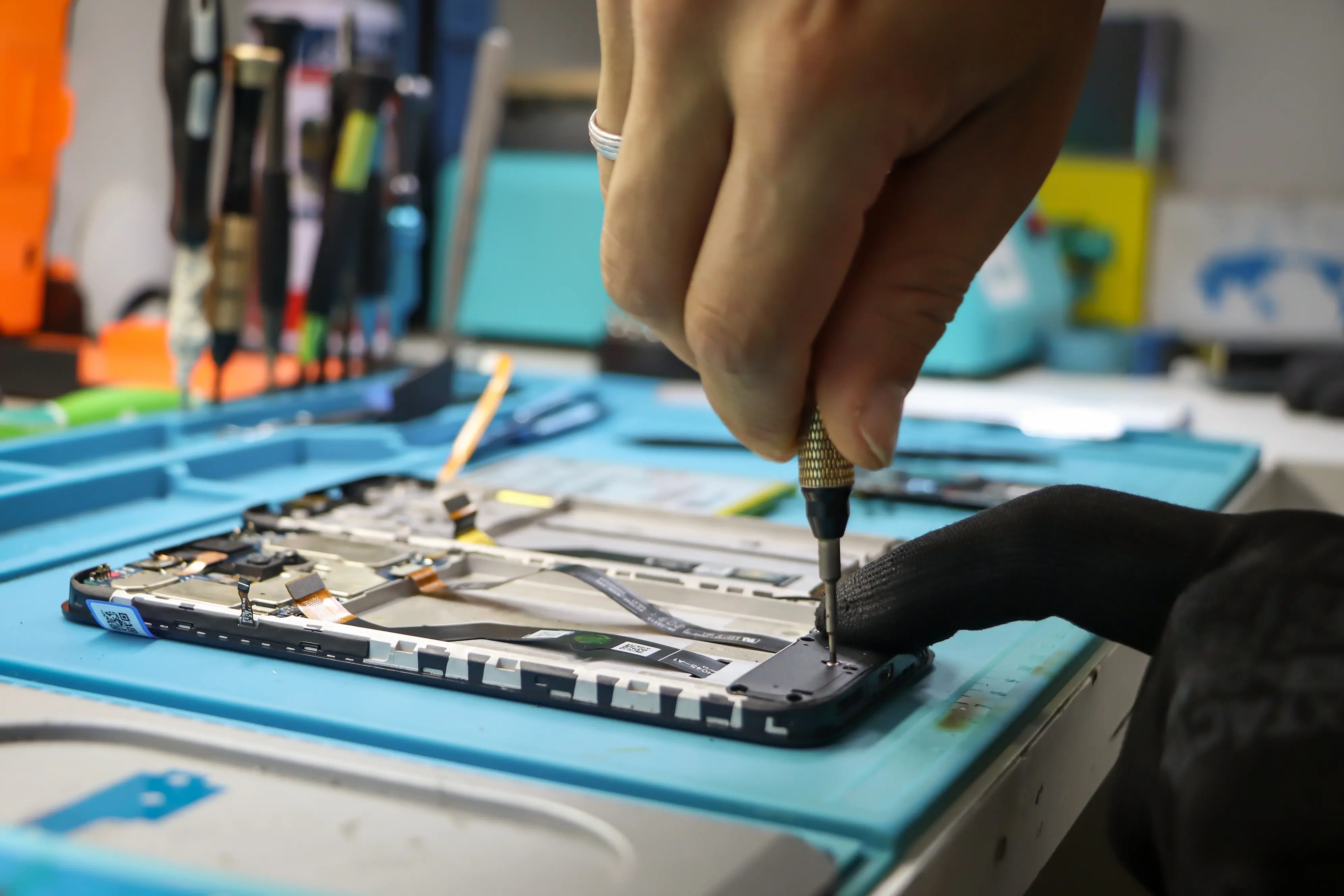In a phone repair shop, your team is your reputation. If they’re not working together, everything suffers — turnaround times stretch, mistakes pile up, and customers lose trust.
Every step runs through your staff from the moment a ticket comes in to the final handoff. And when training is spotty or roles aren’t clear, it shows in rework, delays, and frustrated customers chasing updates that should’ve been handled already.
Learning how to manage employees in a repair shop starts with structure — consistent workflows, clear expectations, and making sure every technician knows what to do and how to do it, even when the shop gets slammed.
Here are nine simple ways to build a team that communicates clearly, takes ownership, and keeps your shop running at peak performance every day.
1. Start With Structured Training
New hires can’t succeed if they’re left to figure things out on their own. Without clear training, mistakes happen, jobs drag on, and your workflow falls apart. A structured onboarding process gets your team up to speed faster and keeps everything running smoothly from day one.
Set them up for success from the beginning by doing the following:
-
Walk them through your workflow, safety rules, and how to talk to customers.
-
Build checklists for standard tasks like screen replacements, charging port repairs, and inspections.
-
Use your repair tracking software to assign mock jobs, practice logging notes, and teach proper documentation, like updating job statuses before they touch a customer’s device.
These strategies build habits that lead to faster turnaround times, fewer errors, and more consistent results on every repair.
2. Set Clear Customer Service Standards
Every customer interaction can impact your shop’s reputation. An essential part of training staff is teaching them to speak clearly, respectfully, and professionally — even when a repair takes longer than expected or costs more than the customer hoped.
Set the tone with straightforward tools:
-
Practice simple scripts explaining delays, repair costs, or warranty terms without overexplaining or sounding defensive.
-
Roleplay troubleshooting common issues like angry customers, misdiagnoses, or repeat complaints.
-
Post a service cheat sheet near workstations with tips on tone, key phrases, and how to handle common customer questions.
Consistent messaging builds customer trust and helps prevent minor problems from escalating into lost business.
3. Use Repair Tracking Software To Assign and Monitor Jobs
Without the right system, one tech is buried in work while another sits idle. Repair tracking software helps you assign jobs fairly, hit deadlines, and catch issues early without micromanaging your team.
Create a dedicated workflow to keep your team focused and ahead of schedule:
-
Assign work based on each employee’s strengths, speed, and certifications.
-
Track job status and updates in real time to keep everyone accountable.
-
Pull reports to identify delays, missed steps, or areas where someone might need retraining.
This approach to managing employees keeps your queue moving and helps you deliver on time without burning out your best technicians.
4. Give Employees a Voice in Daily Operations
Your technicians are closest to the work and usually the first to notice what’s not working.
Giving them a voice in the shop's operations gives them a stronger buy-in and fewer avoidable mistakes.
Make feedback part of your process for how to manage employees:
-
Set up a suggestion board or carve out time for active listening at weekly team meetings.
-
Ask for input on tool purchases, workflow changes, or software updates.
-
Recognize ideas that improve turnaround times or reduce callbacks.
Small changes from team members can lead to faster repairs and processes, plus fewer repeated mistakes on the floor.
5. Make Recognition Part of the Culture
Happy technicians are more productive. One major study found that workers are 13% more productive when they feel happy at work. A quick thank-you or public shoutout can make a big impact, especially in a fast-paced repair shop where there’s not always time for formal recognition.
Look for simple ways to spotlight good work:
-
Highlight wins at team meetings, like first-time fix rates, upsells, or great reviews.
-
Use your repair tracking system to see who’s consistently meeting deadlines.
-
Offer easy rewards like gift cards, team lunches, or a name on the whiteboard.
Recognition keeps morale high and helps reinforce the habits you want every tech to repeat.
6. Encourage Employee Accountability
When employees take pride in holding each other to a high standard, you get better repairs and fewer do-overs. But peer accountability doesn’t replace leadership skills. Rather, it supports it and builds a more capable, reliable team.
Make those habits part of the day-to-day:
-
Pair experienced technicians with newer hires for informal mentoring.
-
Set up an approval system where a second technician double-checks repairs before final sign-off.
-
Use your point of sale (POS) system to log who approved each job and track any recurring issues to see where training or refresher courses are needed.
This strategy gives everyone on your team responsibility and a role in quality control, leading to a more cohesive staff and better services for your customers.
7. Support Mental and Physical Wellness
Repair work is physical, repetitive, and often done under pressure. If your technicians feel burned out or worn down, the quality of work and customer retention can drop quickly.
Keep your staff healthy and focused with simple practices:
-
Offer stretch breaks and ear protection, and keep hydration stations stocked and accessible during long shifts.
-
Rotate high-stress tasks when possible to avoid burnout — like diagnosing tricky issues under pressure or handling frustrated customers at the front desk.
-
Provide flexible time off, paid mental health days, or workplace wellness courses if your budget allows.
Even small changes can help prevent repetitive strain injuries, reduce sick days, and keep your team focused and energized.
8. Lead With Respect, Not Pressure
The way you manage your team shapes how they show up every day. Research shows that 70% of the difference in employee engagement comes down to the manager. When you lead with respect — even under pressure or when mistakes happen — you create a workplace where people stay focused, motivated, and proud of their work.
Focus on consistency over control:
-
Stay calm during high-pressure jobs or when a mistake happens.
-
Avoid public callouts and use one-on-one conversations for performance issues.
-
Model professionalism with punctuality, follow-through, and clear expectations.
Respectful leadership develops a positive work environment where employees stay accountable and speak up when something’s off.
9. Use Data To Improve Performance
If your team sees every report as a setup for blame, honesty goes out the window. But when data is framed as a tool for growth — not punishment — it builds trust and gives everyone a clear path to improvement.
Keep the focus on progress, not pressure:
-
Use your repair tracking system’s reports to identify trends, slowdowns, or recurring issues. Flag them early and follow up with coaching.
-
Share productivity goals openly and talk through tangible steps on how to hit them as a team.
-
Reinforce the idea that reports are there to support the team, not single people out, especially when discussing performance in group settings.
When used correctly, data builds trust, strengthens training, and helps you spot problems before they become bigger issues.
Rethink How To Manage Employees in Your Repair Shop
Learning how to manage employees in a repair shop means balancing team development with fast, accurate service. You need a management approach, clear accountability, the right tools to support your team on the floor and the systems that keep everything running.
CellSmart POS gives you that foundation. Use repair ticket management to assign jobs, track technician progress, and consistently meet deadlines. On the employee side, track hours with the time clock, monitor progress with performance reports, and motivate your team using commission tracking — all in one system.
It’s everything you need to manage your team while staying focused on what your repair shop does best. Request a demo today to see how CellSmart POS supports your staff and improves your workflow.




